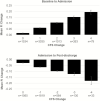Exploring Clinically Meaningful Changes for the Frailty Index in a Longitudinal Cohort of Hospitalized Older Patients
- PMID: 32274501
- PMCID: PMC7518565
- DOI: 10.1093/gerona/glaa084
Exploring Clinically Meaningful Changes for the Frailty Index in a Longitudinal Cohort of Hospitalized Older Patients
Abstract
Background: Clinically meaningful change (CMC) for frailty index (FI) scores is little studied. We estimated the CMC by associating changes in FI scores with changes in the Clinical Frailty Scale (CFS) in hospitalized patients.
Methods: The Serious Outcomes Surveillance Network of the Canadian Immunization Research Network enrolled older adults (65+ years) admitted to hospital with acute respiratory illness (mean age = 79.6 ± 8.4 years; 52.7% female). Patients were assigned CFS and 39-item FI scores in-person at admission and via telephone at 1-month postdischarge. Baseline frailty state was assessed at admission using health status 2 weeks before admission. We classified those whose CFS scores remained unchanged (n = 1,534) or increased (n = 4,390) from baseline to hospital admission, and whose CFS scores remained unchanged (n = 1,565) or decreased (n = 2,546) from admission to postdischarge. For each group, the CMC was represented as the FI score change value that best predicted one level CFS change, having the largest Youden J value in comparison to no change.
Results: From baseline to admission, 74.1% increased CFS by ≥1 level. From admission to postdischarge, 61.9% decreased CFS by ≥1 levels. A change in FI score of 0.03 best predicted both one-level CFS increase (sensitivity = 70%; specificity = 69%) and decrease (sensitivity = 66%; specificity = 61%) in comparison to no change. Of those who changed CFS by ≥1 levels, 70.9% (baseline to admission) and 72.4% (admission to postdischarge) changed their FI score by at least 0.03.
Conclusions: A clinically meaningful change of 0.03 in the frailty index score holds promise as a benchmark for assessing the meaningfulness of frailty interventions.
Keywords: Aging; Clinical frailty scale; Clinically meaningful change; Frailty index.
© The Author(s) 2020. Published by Oxford University Press on behalf of The Gerontological Society of America. All rights reserved. For permissions, please e-mail: journals.permissions@oup.com.
Figures
Similar articles
-
Canadian Study of Health and Aging Clinical Frailty Scale: Does It Predict Adverse Outcomes among Geriatric Trauma Patients?J Am Coll Surg. 2017 Nov;225(5):658-665.e3. doi: 10.1016/j.jamcollsurg.2017.08.008. Epub 2017 Sep 6. J Am Coll Surg. 2017. PMID: 28888692
-
Complementing chronic frailty assessment at hospital admission with an electronic frailty index (FI-Laboratory) comprising routine blood test results.CMAJ. 2020 Jan 6;192(1):E3-E8. doi: 10.1503/cmaj.190952. CMAJ. 2020. PMID: 31907228 Free PMC article.
-
Frailty and Risk of Adverse Outcomes in Hospitalized Older Adults: A Comparison of Different Frailty Measures.J Am Med Dir Assoc. 2017 Jul 1;18(7):638.e7-638.e11. doi: 10.1016/j.jamda.2017.04.011. Epub 2017 Jun 3. J Am Med Dir Assoc. 2017. PMID: 28587850
-
A scoping review of the Clinical Frailty Scale.BMC Geriatr. 2020 Oct 7;20(1):393. doi: 10.1186/s12877-020-01801-7. BMC Geriatr. 2020. PMID: 33028215 Free PMC article.
-
The Comprehensive Complication Index is Related to Frailty in Elderly Surgical Patients.J Surg Res. 2019 Dec;244:218-224. doi: 10.1016/j.jss.2019.06.011. Epub 2019 Jul 10. J Surg Res. 2019. PMID: 31301477 Review.
Cited by
-
Eight-Year Changes in Multimorbidity and Frailty in Adults With Type 2 Diabetes Mellitus: Associations With Cognitive and Physical Function and Mortality.J Gerontol A Biol Sci Med Sci. 2022 Aug 12;77(8):1691-1698. doi: 10.1093/gerona/glab342. J Gerontol A Biol Sci Med Sci. 2022. PMID: 34788804 Free PMC article. Clinical Trial.
-
Cross-sectional and longitudinal associations among healthcare costs and deficit accumulation.J Am Geriatr Soc. 2024 Sep;72(9):2759-2769. doi: 10.1111/jgs.19053. Epub 2024 Jul 1. J Am Geriatr Soc. 2024. PMID: 38946518 Free PMC article.
-
Frailty assessment for COVID-19 follow-up: a prospective cohort study.BMJ Open Respir Res. 2022 Apr;9(1):e001227. doi: 10.1136/bmjresp-2022-001227. BMJ Open Respir Res. 2022. PMID: 35459694 Free PMC article.
-
Interrupting bedtime to reverse frailty levels in acute care: a study protocol for the Breaking Bad Rest randomized controlled trial.BMC Geriatr. 2023 Aug 10;23(1):482. doi: 10.1186/s12877-023-04172-x. BMC Geriatr. 2023. PMID: 37563553 Free PMC article.
-
Markers of systemic inflammation are positively associated with influenza vaccine antibody responses with a possible role for ILT2(+)CD57(+) NK-cells.Immun Ageing. 2022 May 26;19(1):26. doi: 10.1186/s12979-022-00284-x. Immun Ageing. 2022. PMID: 35619117 Free PMC article.



